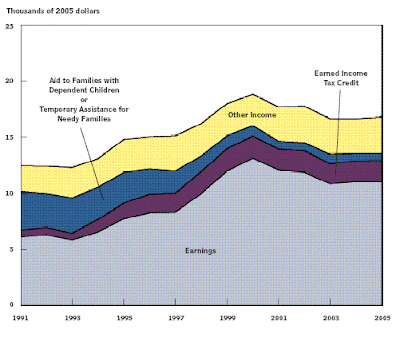A new study by the Congressional Budget Office says the poor have been getting less poor. On average, CBO found that low-wage households wih children had incomes after inflation that were more than one third higher in 2005 than in 1991... Among all families with children, the poorest fifth had the fastest overall earnings growth over the 15 years measured... When CBO examined surveys of the same poor families over a two year period, 2001-2003, it found that 'the average income for those households increased by nearly 45%'... It's probably asking way too much for this dose of economic reality to slow down the class envy lobby in Washington. But it's worth a try.
[An accompanying chart shows that from 1991-2005, among families with children, earnings increased 78% for the poorest 20%, 23% for the next poorest 20%, 18% for the middle 20%, 22% for the second richest 20%, and 54% for the richest 20%.]
Speaking on behalf of the class envy lobby, let me explain why we've been ignoring this good news.
1. We in the CEL care about all people, not just families with children. According to the study, households in the lowest quintile without children experienced no real increase in income between 1991 and 2005.
2. True, according to the chart the poorest 20% had the highest earnings growth (78%). But income growth includes earnings (wages times hours worked) plus investment income, cash transfers from government, etc. Growth in total income was much lower - 35%, according to the study. This is a lower rate of increase than achieved by higher income groups.
3. 35% income growth is not all that impressive. From 1991 to 2005, real disposable personal income overall rose by about 51%. That means incomes of the bottom 20% were falling behind the average.
4. All of the growth in incomes occurred before 2000. During the Bush presidency, incomes have fallen. Here's where the WSJ really has to work to avoid the obvious, since the graph below is on the cover of the report!

4. It's true that computing the average earnings of the poorest 20% in two different years does not give you the same information as tracking the earnings of individual households over time. It's true that average real earnings for households that were in the poorest 20% in 2001 rose by 45 percent by 2003. But this is to be expected; among those poor households were many people who were unemployed in 2001 and found jobs by 2003 (the report notes that essentially all of the increase in earnings was due to increases in hours worked, not wages). Among those who were poor in 2001 were families who saw their income temporarily fall because, say, they didn't receive child support payments that year (the report notes that changes in child support payments were a major factor in 17% of families that saw their incomes rise and 13% of families that saw their incomes fall).
5. As a simple matter of mathematics, if the incomes of individuals who started out poor in 2001 rose in 2003 while the average income of the poorest 20% fell during the same period, then people who started out in higher income groups in 2001 must have experienced greater income losses (that is, if we ignore the effect of new immigrants into the poorest strata, which is a small effect). For example, suppose there are four people in the country, with incomes of $10,000, $20,000, $30,000, and $40,000 in 2001. The poorest half has an average income of $15,000, the richest half $35,000. Suppose I know that in 2003, the average income in the poorest half fell to $10,000, while the incomes of the poorest two individuals rose to $15,000 and $25,000, respectively. The only way this could happen is if one or both of the households that were rich in 2001 experienced large income declines. For example, if the household that earned $30,000 in 2001 saw its income fall to $5000, the 2003 income distribution would be $5000, $15,000, $25,000, $40,000. So if the WSJ is going to crow about gains to those who were poor in 2001, they ought also to note the losses that must have occurred to others (almost certainly for the most part middle class families rather than the very rich).
So on behalf of the CEL, let me offer the WSJ this deal. We will stop harping about the plight of the poor and middle class if you will support a return to the economic policies of the 1990s that produced the (apparently short-lived) gains that accrued to those groups: strong economic growth, increase in minimum wage, and expansion of the earned income tax credit and health insurance to the poor.











0 comments:
Post a Comment